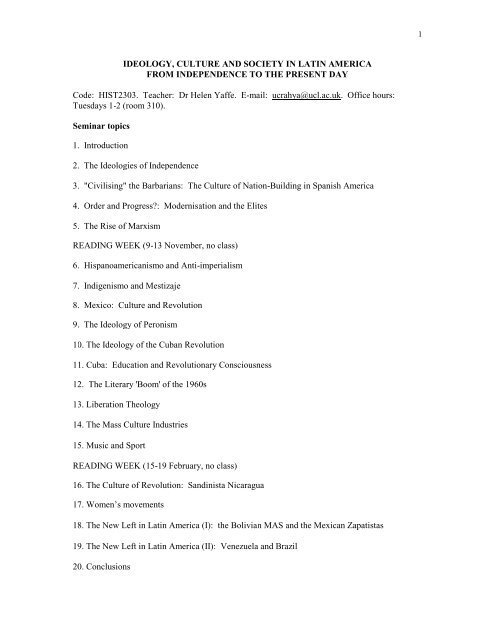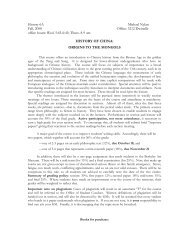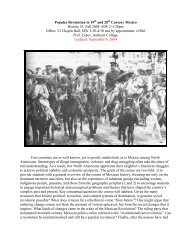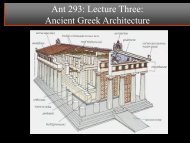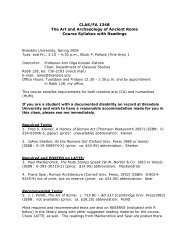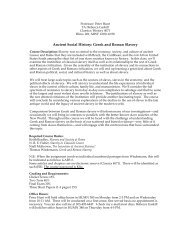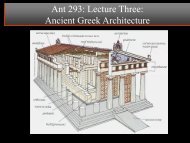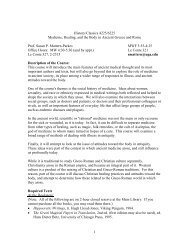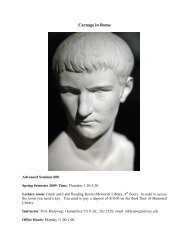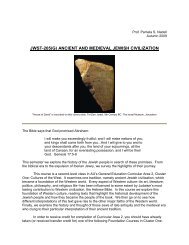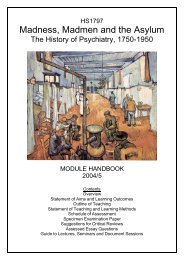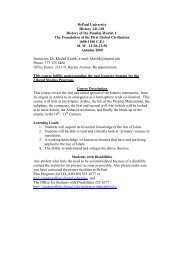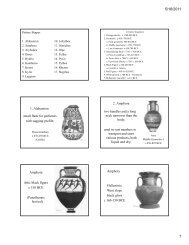IDEOLOGY, CULTURE AND SOCIETY IN LATIN AMERICA FROM ...
IDEOLOGY, CULTURE AND SOCIETY IN LATIN AMERICA FROM ...
IDEOLOGY, CULTURE AND SOCIETY IN LATIN AMERICA FROM ...
Create successful ePaper yourself
Turn your PDF publications into a flip-book with our unique Google optimized e-Paper software.
10Diego Rivera; Art and Revolution, exhibition catalogue, 1999.FAVELA, Ramon, Diego Rivera, 1984.FOLGARAIT, Leonard, So Far From Heaven: David Alfaro Siquieros' 'The March fromHeaven' and Mexican Revolutionary Politics, 1987.Frida Kahlo, Diego Rivera, and Twentieth-Century Mexican Art: The Jacques and NatashaGelman Collection, 2000.HEDRICK, Tace, Mestizo Modernism: Race, Nation and Identity in Latin American Culture1900-1940, 2003 (chapters on Rivera and Kahlo).HELMS, Cynthia Newman, ed., Diego Rivera, 1986.HERRERA, Hayden, Frida, A Biography of Frida Kahlo, 1998.KAHLO, Frida, The Diary of Frida Kahlo: An Intimate Self-Portrait, 1995.L<strong>IN</strong>DAUER, Margaret, Devouring Frida: The Art History and Popular Celebrity of FridaKahlo, 1999.MARNHAM, Patrick, Dreaming With His Eyes Open: A Life of Diego Rivera, 1999.M<strong>IN</strong>ISTRY of Foreign Affairs and Institute of Fine Arts, Mexico, Orozco!, 1980.Rivera: A Retrospective, The Hayward Gallery, London, 1987.OROZCO, José Clemente, An Autobiography, trans. 1962.ROCHFORT, Desmond, The Murals of Diego Rivera, 1987; and Mexican Muralists: Orozco,Rivera and Siqueiros, 1993.SIQUEIROS, David Alfaro, Art and Revolution, trans. 1975. Manifesto.WOLFE, Bertram, The Fabulous Life of Diego Rivera, 1999.National identityAZUELA, Mariano, The Underdogs [1915], trans. 1962 and 1992. The most famous novel of theMexican Revolution.BARTRA, Roger, The Cage of Melancholy: Identity and Metamorphosis in the MexicanCharacter, trans. 1992. Essay by leading Mexican anthropologist and cultural commentator.BENJAM<strong>IN</strong>, Thomas, La Revolución: Mexico’s Great Revolution as Memory, Myth andHistory, 2000.BRITTON, John A., ed., Molding the Hearts and Minds, 1994, ch. by Mary Kay Vaughan, ‘TheEducational Project of the Mexican Revolution: The Response of Local Societies (1934-1940)’.CAMP, Roderic, Intellectuals and the State in Twentieth-Century Mexico, 1985.COCKCROFT, J. D., Intellectual Precursors of the Mexican Revolution, 1969.FUENTES, Carlo, The Death of Artemio Cruz [1962], trans. 1977 and 1990. Novel.GRAHAM, Richard, ed., The Idea of Race in Latin America, 1870-1940, 1991, chapter by AlanKnight, ‘Racism, revolution, and indigenismo: Mexico, 1910-1940’, pp. 71-113.KNIGHT, Alan, 'Popular Culture and the Revolutionary State in Mexico, 1910-1940', HispanicAmerican Historical Review, 74:3, Aug. 1994, pp. 393-444.LOMNITZ-ADLER, Claudio, Exits from the Labyrinth: Culture and Ideology in the MexicanNational Space, 1992.SCHMIDT, Henry C., The Roots of Lo Mexicano: Self and Society in Latin American Thought,1900-1934, 1978.STABB, Martin, In Quest of Identity, 1967, ch. VII, ‘The Search for Essence in Mexico andElsewhere’.VAUGHAN, Mary Kay, Cultural Politics in Revolution: Teachers, Peasants, and Schools inMexico, 1930-1940, 1997.---- The State, Education, and Social Class in Mexico, 1880-1928, 1982. Good on the 1920s.VAUGHAN, Mary Kay and Stephen M. Lewis, eds., The Eagle and the Virgin: Nation andCultural Revolution in Mexico, 1920-1940, 2006, chs. by Desmond Rochfort on the muralists andClaudio Lomnitz on ‘Final Reflections: What Was Mexico’s Cultural Revolution?’
119. The Ideology of PeronismSet TextsPERON, Eva, My Mission in Life, 1953; and In My Own Words, trans. 1996.PERON, Juan Domingo, Bill of Rights of the Workers, 1947 [available at Senate House library].Further readingAUYERO, Javier, Poor People’s Politics: Peronist Survival Networks and the Legacy of Evita,2000.BRENNAN, James, ed., Peronism and Argentina, 1998.BRITTON, John A., ed., Molding the Hearts and Minds, 1994, ch. by Ruth and LeonardGreenup, ‘Education for Perón’.CIRIA, Alberto, 'Flesh and Fantasy: The Many Faces of Evita (and Juan Perón)', Latin AmericanResearch Review, 18 (1983), 150-65.DUJOVNE ORTIZ, Alicia, Evita Perón, 1997.IVEREIGH, Austen, Catholicism and Politics in Argentina, 1810-1960, 1995, ch. 5 onCatholicism and Peronism.ELOY MART<strong>IN</strong>EZ, Tomás, The Perón Novel, 1988; and Santa Evita, 1997. Both novels.KATRA, William, Contorno: Literary Engagement in Post-Peronist Argentina, 1988 [earlychapters contain useful material on the Peronist period itself].K<strong>IN</strong>G, John, Sur: A Study of the Argentine Literary Journal and its Role in the Development ofa Culture, 1931-1970, 1986. Sur was the focus of intellectual resistance to Perón, although itwas largely passive resistance.MALLEA, Eduardo, History of an Argentine Passion [1940], trans. 1983. This is a ‘nationalcharacter’ essay, which antedates Peronism itself, but gives you a good idea of the context inwhich Peronism emerged, as doesMART<strong>IN</strong>EZ ESTRADA, Ezequiel, X-Ray of the Pampa [1933], trans. 1971.MUNCK, R., Argentina: From Anarchism to Peronism, 1987, chapter 10 onwards.PLOTK<strong>IN</strong>, Mariano, Mañana es San Perón: A Cultural History of Perón’s Argentina, 2003.RANIS, P., Argentine Workers: Peronism and Contemporary Class Consciousness, 1992; or therev’d edn., Class, Democracy and Labor in Contemporary Argentina, 1995.RE<strong>IN</strong>, Mónica Esti, Politics and Education in Argentina, 1946-1962, 1998. Chapters 2 and 3 aregood on Peronist education policy; chapter 1 is a useful introduction to Peronist ideology.RUIZ JIMENEZ, Laura, ‘Peronism and Anti-Imperialism in the Argentine Press: “Braden orPerón” Was Also “Perón is Roosevelt”’, Journal of Latin American Studies, 30:4, Nov. 1998,551-71.STABB, Martin, ‘Argentine Letters and the Peronato: An Overview’, Journal of Inter-americanStudies, XIII:3-4 July-Oct. 1971, 434-55.TAYLOR, Julie M., Evita Peron: The Myths of a Woman, 1979.
1311. Revolutionary Cuba: Education and ConsciousnessSet Texts: GUEVARA, Ernesto ‘Che’, Man and Socialism in Cuba, 1965. Available athttp://www.marxists.org/archive/guevara/1965/03/man-socialism.htmYAFFE, Helen, Che Guevara: The economics of revolution, 2009, chapter 4 ‘Education, trainingand salaries’ & chapter 8 ‘Consciousness and psychology’.Further readingBERNARDO, Robert, The Theory of Moral Incentives in Cuba, 1971.BOORSTE<strong>IN</strong>, Edward, The Economic Transformation of Cuba: A First Hand Account, 1968.BUNCK, Julie, Fidel Castro and the Quest for a Revolutionary Culture in Cuba, 1994.CARNOY, Martin, et al., Cuba’s Academic Advantage: Why Students in Cuba Do Betterin School, 2007.COD<strong>IN</strong>A JIMENEZ, Alex, ‘Worker Incentives in Cuba’ in World Development, Vol. 15,No. 1 (1987), pp. 127-138.FAGEN, Richard, The Political Content of Adult Education, 1964 (analyses the manualsused during the Literacy Campaign); and The Transformation of Political Culture inCuba, 1969.FREIRE, Paulo, Pedagogy of the Oppressed, 1972 and later edns.GLEIJESES, Piero, ‘A History Worthy of Pride’ in Tricontinental, Vol. 38, No. 158,(2004) available at: http://www.socialistvoice.ca/?p=66GRAY, Alexander, and Antoni Kapcia, The Changing Dynamic of Cuban Civil Society, 2008.HARRIS, Richard, ‘Cuban Internationalism, Che Guevara, and the Survival of Cuba’sSocialist Regime’ in Latin American Perspectives, Vol. 36, No. 3 (May 2009), 27-42.HENNESSY, Alastair, ed., Intellectuals in the Twentieth-Century Caribbean, vol. II 1992, chs.by Antoni Kapcia for background; and Nicola Miller, ‘The intellectual in the Cuban Revolution’.HERN<strong>AND</strong>EZ-REGUANT, Ariana (ed.), Cuba in the Special Period: Culture andIdeology in the 1990s, 2009. Collection of essays covering diverse areas of culture.KAPCIA, Antoni, ‘Educational revolution and revolutionary morality in Cuba: the 'New Man',youth and the new 'Battle of Ideas’, in Journal of Moral Education, Vol. 34, No. 4, December2005, pp. 399–412.JUDSON, Fred C., Cuba and the revolutionary myth : the political education of the Cuban RebelArmy, 1953-1963, 1984.LUTJENS, Sheryl, The State, Bureaucracy, and Cuban Schools, 1996.RABY, D.L, Democracy and Revolution: Latin America and Socialism Today, 2006, chapter 4‘Originality and Relevance of the Cuban Revolution’.LOWY, Michael, The Marxism of Che Guevara: Philosophy, Economics and RevolutionaryWarfare, 1973.McCAUGHAN, Edward, Reinventing Revolution: The Renovation of Left Discourse in Cubaand Mexico, 1997.McLAREN, Peter, ‘Che Guevara, Paulo Freire, and the Politics of Hope: Reclaiming CriticalPedagogy’, Cultural Studies-Critical Methodologies, Vol 1:1 (2000) http://www.chelives.com/home/modules.php?name=Content&pa=showpage&pid=14MILLER, Nicola, ‘A Revolutionary Modernity: The Cultural Policy of the Cuban Revolution’,Journal of Latin American Studies, vol. 40, Nov. 2008, pp. 675-96.SANEY, Isaac, ‘Homeland of Humanity: Internationalism and the Cuban Revolution’ in LatinAmerican Perspectives, Vol 36: No 1 (January 2009).REED, Roger, The Cultural Revolution in Cuba, 1991.ROSENDAHL, Mona, Inside the Revolution: Everyday Life in Socialist Cuba, 1997.SMORKALOFF, Pamela Maria, Readers and Writers in Cuba: A Social History of PrintCulture, 1830s-1990s, 1997.YGLESIAS, Jose, In the Fist of the Revolution: Life in Castro’s Cuba, Pelican. 1970.
1412. The Literary 'Boom' of the 1960sSet textsDONOSO, José, The "Boom" in Spanish American Literature: A Personal History [1972], trans.1977.FUENTES, Carlos, 'Gabriel García Márquez and the invention of America', in Myself withOthers, 1988.GARCIA MARQUEZ, Gabriel, One Hundred Years of Solitude, 1970. See also his Nobel Prizeacceptance speech, reproduced in McGUIRK, G., and R. Cardwell, eds., Gabriel GarcíaMárquez, 1987.IntroductionMART<strong>IN</strong>, Gerald, Journeys through the Labyrinth: Latin American fiction in the twentiethcentury, 1989, especially Chapter 7, 'The "Boom" of the 1960s'; Chapter 8 is also useful.Further readingBLAYER, María F. and Mark Anderson, Latin American Narratives and Cultural Identity:Selected Readings, 2004.DOVE, Patrick, The Catastrophe of Modernity: Tragedy and the Nation in Latin AmericanLiterature, 2004.FRANCO, Jean, 'From modernization to resistance: Latin American literature 1959-1976', LatinAmerican Perspectives, V:1, Winter 1978.GARCIA MARQUEZ, Gabriel, Living to Tell the Tale, 2003.K<strong>IN</strong>G, John ed., Modern Latin American Fiction: A Survey, 1987.McGUIRK, G. and R. Cardwell, Gabriel García Márquez, 1987, ch. by Gerald Martin, ‘On“magical” and social realism in García Márquez’.MEYER, Doris ed., Lives on the Line: The Testimony of Contemporary Latin American Authors1988 and 1989.MILLER, Yvette and Raymond L. Williams, The Boom in Retrospect: A Reconsideration, 1987.NERUDA, Pablo, Memoirs, trans. 1978, various editions.13. Liberation TheologySet TextGUTIERREZ, Gustavo, A Theology of Liberation, 1974, rev. edn. 1988.A summary of his ideas can be found in his ‘Liberation, Theology and Proclamation’, in ClaudeGeffre and Gutiérrez, eds., The Mystical and Political Dimensions of the Christian Faith, 1974,pp. 53-77.Further readingBERRYMAN, P., Stubborn Hope: Religion, Politics and Revolution in Central America, 1994.BERRYMAN, P., Religion in the Megacity: Catholic and Protestant Portraits from Latin America,1997. Mostly testimonial evidence, but interesting on the relative popularity of the two faiths.BERRYMAN, P., Liberation Theology, 1987.
15BOFF, Leonardo, Church: Charisma and Power. Liberation Theology and the InstitutionalChurch, 1985; and Introducing Liberation Theology, 1987. A leading Brazilian LiberationTheologian, famously excommunicated by Pope John Paul II.Bulletin of Latin American Research, vol. 18, no. 2, April 1999, special issue on SocialMovements and Religious Change.BURDICK, John, Looking for God in Brazil : The Progressive Catholic Church in Urban Brazil'sReligious Arena, 1993.CHESNUT, R. A., Assembly of the Anointed: Pentecostalism and the Pathogens of Poverty in anAmazonian City of Brazil, 1962-93, 1995.CLEARY, Edward, Crisis and Change: the Church in Latin America today, 1985; Path fromPuebla: Significant Documents of the Latin American Bishops since 1979, 1988; Born of thePoor: the Latin American Church since Medellin, 1990.CLEARY, Edward and Hannah Stewart-Gambino, eds., Conflict and Competition - The LatinAmerican Church in a Changing Environment, 1992.CLEARY, Edward and Timothy Steigenga, eds., Resurgent Voices in Latin America: IndigenousPeoples, Political Mobilization, and Religious Change, 2004.DUSSEL, Enrique, The Church in Latin America, 1992, esp. ch. 9, 'From the Second VaticanCouncil to the present day' and ch. 22, 'Recent Latin American Theology'.DUSSEL, Enrique, Beyond Philosophy: Ethics, History, Marxism, and Liberation Theology,2003.HENNELLY, Alfred, ed., Liberation Theology: A Documentary History, 1990.KEOGH, Dermot ed., Church and Politics in Latin America, 1990.LEV<strong>IN</strong>E, Daniel, Popular Voices in Latin American Catholicism, 1992.LOWY, Michael, The War of Gods: Religion and Politics in Latin America, 1996. Part 2 is goodon liberation theology.MA<strong>IN</strong>WAR<strong>IN</strong>G, Scott and Alexander Wilde eds., The Progressive Church in Latin America,1989.MART<strong>IN</strong>, David, Tongues of Fire: The Explosion of Protestantism in Latin America, 1990.MARTY, Martin E., and R. Scott Appleby, eds., Fundamentalisms and Society, 1993, ch. bySusan Rose and Quentin Schultze, ‘The Evangelical Awakening in Guatemala: FundamentalistImpact on Education and the Media’.MILLER, Daniel, ed., Coming of Age: Protestantism in Contemporary Latin America, 1994.PELTON, Robert, ed., Monsignor Romero: A Bishop for the Third Millenium, 2004.SIGMUND, Paul, Liberation Theology at the Crossroads: Democracy or Revolution?, 1990.SMITH, Christian, and Joshua Prokopy, Latin American Religion in Motion, 1999, esp. ch. 1,‘The Struggle to be Soul Provider’ and 6, ‘El Clamor por Venezuela: Latin AmericanEvangelicism as a Collective Action Frame’.14. The Mass Culture IndustriesIntroductionsFRANCO, Jean, 'What's in a name? Popular culture theories and their limitations', in her CriticalPassions: Selected Essays, 1999, pp. 169-80. See also pp. 208-20.Further readingBEEZLEY, W. and L. Curcio-Hagy, eds., Latin American Popular Culture: An Introduction,2000.BRITTON, John A., ed., Molding the Hearts and Minds, 1994, ch. by Alan Wells, ‘TheAmericanization of Latin American Television’.
16BUENO, Eva. P. and Terry Caesar, Imagination Beyond Nation: Latin American PopularCulture, 1998.BURTON, Julienne ed., Cinema and Social Change in Latin America, 1986; interviews withLatin American directors.COLE, Richard R., ed., Communication in Latin America: Journalism, Mass Media, andSociety, 1996.DEVER, Susan, Celluloid Nationalism and Other Melodramas: From Postrevolutionary Mexicoto fin de siglo Mexamérica, 2003.DORFMAN, Ariel and A. Mattelart, How to read Donald Duck: Imperialist Ideology inthe Disney Comic, 1975.FOSTER, D. W., From Mafalda to Los Supermachos: Latin American Graphic Humour asPopular Culture, 1989.FOX, Elizabeth ed., Media and Politics in Latin America, 1988. Her introduction, ‘MediaPolicies in Latin America: An Overview’ is useful.GARCIA CANCL<strong>IN</strong>I, Néstor, Transforming Modernity: Popular Culture in Mexico, 1993.HART, Stephen, A Companion to Latin American Film, 2004.HAYES, Joy, Radio Nation: Communication, Popular Culture, and Nationalism in Mexico,1920-1950, 2000.H<strong>IN</strong>DS, Harold E. and Charles M. Tatum, eds., Handbook of Latin American Popular Culture,1985.JOHNSON, Randall, The Film Industry in Brazil, 1987.JOSEPH, Gilbert, et al., eds., Fragments of a Golden Age: The Politics of Culture in Mexicosince 1940, 2001.JOSEPH, Gilbert et al., eds., Close Encounters of Empire, 1998, ch. by Seth Fein, ‘EverydayForms of Transnational Collaboration: US Film Propaganda in Cold War Mexico’.K<strong>IN</strong>G, John, Magical Reels: A History of Cinema in Latin America, 1990 and new edn, 2000.MAHAN, E., 'Communications, culture and the state in Latin America', Journal of Inter-American Studies, Spring 1990.PARKER, Andrew, et al., Nationalisms and Sexualities, 1992, ch. by Julianne Burton, ‘Don(Juanito) Duck and the Imperial-Patriarchal Unconscious’.PILCHER, Jeffrey, Cantiflas and the Chaos of Mexican Modernity, 2002.PUIG, Manuel, Betrayed by Rita Hayworth, 1984; Heartbreak Tango, 1987; Kiss of theSpiderwoman, 1976. Novels.RUB<strong>IN</strong>STE<strong>IN</strong>, Anne, Bad Language, Naked Ladies, and Other Threats to the Nation: APolitical History of Comic Books in Mexico, 1998.SHAW, Lisa, and Stephanie Dennison, eds., Latin American Cinema: Essays on Modernity,Gender and National Identity, 2005.SHAW, Lisa, and Stephanie Dennison, eds., Pop Culture Latin America: Media, Arts andLifestyle, 2005.SKIDMORE, T. ed., Television, Politics and the Transition to Democracy in Latin America,1992.VARGAS LLOSA, Mario, Aunt Julia and the Scriptwriter, 1983; The Storyteller, 1989.15. Music and SportACOSTA, Leonardo, Cubano be, Cubano bop: One Hundred Years of Jazz in Cuba, trans. 2003.ARBENA, Joseph, Sport and Society in Latin America, 1988.ARBENA, Joseph and David LaFrance, eds., Sport in Latin America and the Caribbean, 2002.BIGENHO, Michelle, Sounding Indigenous: Authenticity in Bolivian Music Performance, 2002.CHASTEEN, John Charles, National Rhythms, African Roots: The Deep History of LatinAmerican Popular Dance, 2004.COLLIER, Simon, The Life, Music and Times of Carlos Gardel, 1986.
17HART, Stephen, and Richard Young, eds., Contemporary Latin American Cultural Studies,2003, various chapters on sport and music.KUSS, Melena, Music in Latin America and the Caribbean: An Encyclopedic History, 2004.MANGAN, J. A., and LaMartine DaCosta, eds., Sport in Latin American Society: Past andPresent, 2002.MASON, Anthony, Passion of the People? Football in South America, 1995.PAC<strong>IN</strong>I, Deborah, Rockin’ las Americas: The Global Politics of Rock in Lain/o America, 2004.ROWE, William and Vivian Schelling, Memory and Modernity: Popular Culture in LatinAmerica, 1991.ROY, Maya, Cuban Music, 2002.SALMAN, Ton, The Legacy of the Disinherited: Popular Culture in Latin America, 1996.SELLERS, Julie, Merengue and Dominican Identity: Music as National Unifier, 2004.SHAW, Lisa, The Social History of the Brazilian Samba, 1999.SUBLETTE, Ned, Cuba and Its Music: From the First Drums to the Mambo, 2004.VIANNA, Hermano, The Mystery of Samba: Popular Music and National Identity in Brazil,trans. John Charles Chasteen, 1999.WADE, Peter, Music, Race and Nation: Música Tropical in Colombia, 2000.ZOLOV, Eric, Refried Elvis: The Rise of the Mexican Counterculture, 1999.16. The Culture of Revolution: Sandinista NicaraguaSet textsHEYCK, Denis Lynn Daly, Life Stories of the Nicaraguan Revolution, 1990, esp. VidaluzMeneses of the Ministry of Culture.MARCUS, Bruce, ed., Nicaragua: The Sandinista People’s Revolution, 1985; see esp. TomásBorge, ‘The New Education in the New Nicaragua’; and Sergio Ramírez, ‘The Relevance ofSandino’s Thought’.Further readingARNOVE, Robert, Education and Revolution in Nicaragua, 1986, esp. ch. 2, ‘The LiteracyCampaign of 1980’.BORGE, Tomas, Christianity and Revolution, 1987. Essay by a Sandinista leader.BRITTON, John A., ed., Molding the Hearts and Minds, 1994, ch. by Donald C. Hodges, ‘Whatis Sandinismo?’.CABESTRERO, Teofilo, Ministers of God, Ministers of the People, 1983.CABEZAS, Omar, Fire from the Mountain: The Making of a Sandinista, 1985. Memoir.COLL<strong>IN</strong>SON, Helen, ed., Women and Revolution in Nicaragua, 1990.CRAVEN, David, The New Concept of Art and Popular Culture in Nicaragua since theRevolution, 1989.GILBERT, Dennis, Sandinistas: the Party and the Revolution, 1988, esp. Part 1, ch. 1, ‘TheIdeology of the Sandinistas’.HODGES, Donald C., Intellectual Foundations of the Nicaraguan Revolution, 1986.MORALES-GOMEZ, Daniel A., and Carlos Alberto Torres, eds., Education, Policy and SocialChange, 1992, ch. by Robert Arnove on Nicaragua.NOLAN, David, The Ideology of the Sandinistas and the Nicaraguan Revolution, 1984.PREVOST, Gary, and Harry E. Vanden, eds., The Undermining of the Sandinista Revolution,1997, ch. 5 by Erica Polakoff and Pierra La Ramée, ‘The Evolution of the Popular Organizationsin Nicaragua’. A similar piece by them appears in Thomas W. Walker, ed., Nicaragua withoutIllusion, 1997.
18R<strong>AND</strong>ALL, Margaret, Sandino's Daughters, 1981; and Sandino’s Daughters Revisited, 1994.VILAS, Carlos M., The Sandinista Revolution, 1986, ch. 6 on education.WHISNANT, David E., Rascally Signs in Sacred Places, 1995, esp. chs. 5 and 6 on theSandinista cultural project and opposition to it.WILLIAMS, Philip, The Catholic Church and Politics in Nicaragua and Costa Rica, 1989, ch. 4,'The Catholic Church in the Nicaraguan Revolution'.17. Women’s MovementsSet textsBARRIOS DE CHUNGARA, Domitila, Let Me Speak, 1978.Further readingALLENDE, Isabel, The House of the Spirits, 1985; Of Love and Shadows, 1987; Eva Luna, 1989.ALVAREZ, Sonia E., Engendering Democracy in Brazil: Women's Movements in TransitionPolitics, 1990.CARLSON, Marifran, Feminismo! The Women’s Movement in Argentina from its Beginnings toEva Perón, 1988.DORE, Elizabeth, ed., Gender Politics in Latin America: Debates in Theory and Practice, 1997.DORE, Elizabeth, and Maxine Molyneux, eds., Hidden Histories of Gender and the State inLatin America, 2000.FRENCH, John, and Daniel James, eds., The Gendered Worlds of Latin American WomenWorkers: From Household and Factory to Union Hall and Ballot Box, 1997.JAQUETTE, Jane, ed., The Women's Movement in Latin America: Feminism and the Transitionto Democracy, 1989.JEL<strong>IN</strong>, Elizabeth, Family, household and gender in Latin America 1990; and Women and socialchange in Latin America, 1990.KAMPWIRTH, Karen, Feminism and the Legacy of Revolution: Nicaragua, El Salvador,Chiapas, 2004.LAVR<strong>IN</strong>, Asunción, Women, Feminism and Social Change in Argentina, Chile and Uruguay,1890-1940, 1995.LOPEZ SPR<strong>IN</strong>GFIELD, Consuelo, Daughters of Caliban, 1997, ch. by Carollee Bengelsdorf,‘Reconsidering Cuban Women in a Time of Troubles’.McGEE DEUTSCH, Sandra, 'Gender and Socio-political Change in Twentieth-century LatinAmerica', Hispanic American Historical Review, 71:2, 1991.MELHUUS, Marit and Kristi Anne Stolen, Machos, Mistresses, Madonnas: Contesting thePower of Latin American Gender Imagery, 1996.MILLER, Francesca, Latin American Women and the Search for Social Justice, 1991.MOLYNEUX, Maxine, State, gender and institutional change in Cuba’s ’special period’: TheFederación de Mujeres Cubanas, 1996.NEW LEFT REVIEW, 173, 1989, 'The Panorama of Brazilian Feminism'.RADCLIFFE, Sarah and Sallie Westwood, "Viva": Women and Popular Protest in LatinAmerica, 1993, esp. ch. 1.RODRIGUEZ, Victoria, ed., Women’s Participation in Mexican Political Life, 1998.SHAYNE, Julie, The Revolution Question: Feminisms in El Salvador, Chile and Cuba, 2004.SMITH, L. and A. Padula, Sex and Revolution: Women in Socialist Cuba, 1996.SOTO, Shirlene, Emergence of the Modern Mexican Woman, 1990.STONER, K. L., From the House to the Streets: The Cuban Women’s Movement for LegalReform, 1991.
19VAUGHAN, Mary Kay, Women of the Mexican Countryside: Creating Spaces, ShapingTransitions, 1994.YAEGER, Gertrude, ed., Confronting Change, Challenging Tradition, 1994, esp. ch. 1 onmarianismo; ch. 17 on women in Nicaragua.18. The New Left in Latin America (I): The Bolivian MAS and the Mexican ZapatistasSet textsSpeeches by Evo Morales (to be distributed).‘First Declaration of the Lacandon Jungle’, 2 Jan. 1994; and ‘Second Declaration of theLacandon Jungle, 12 June 1994, in Subcomandante Marcos, Our Word is Our Weapon: SelectedWritings, ed. Juana Ponce de León, 2001.Further reading: BoliviaALBO, Xavier, ‘Bolivia: From Indian and Campesino Leaders to Councillors and ParliamentaryDeputies’, in Rachel Sieder, ed., Multiculturalism in Latin America: Indigenous Rights,Diversity and Democracy, 2002.ALBRO, Robert, ‘”The Water is Ours Carajo!”: Deep Citizenship in Bolivia’s Water War’, inJune Nash, ed., Social Movements: An Anthropological Reader, 2005.ALBRO, Robert, ‘The Indigenous in the Plural in Bolivian Oppositional Politics’, Bulletin ofLatin American Research, 24:4, Oct. 2005, 433-53.<strong>AND</strong>OL<strong>IN</strong>A, Robert James, Colonial Legacies and Plurinational Imaginaries: IndigenousMovement Politics in Ecuador and Bolivia, 1999.BENNETT, Vivienne et al, eds., Opposing Currents: The Politics of Water and Gender in LatinAmerica, 2005.BRYSK, Alison, From Tribal Village to Global Village: Indian Rights and InternationalRelations in Latin America, 2000.BURT, Jo-Marie and Philip Mauceri, eds., Politics in the Andes: Identity, Conflict, Reform,2004.CANESSA, Andrew, ‘Todos somos indígenas: Towards a New Language of National PoliticalIdentity’, BLAR, 25:2, April 2006, 241-63.CRABTREE, John, Patterns of Protest: Patterns of Social Movements in Bolivia, 2005.GILL, Lesley, Teetering on the Rim: Global Restructuring, Daily Life and the Armed Retreat ofthe Bolivian State, 2000.GOW, D. and J. Rappoport, ‘The Indigenous Public Voice: The Multiple Idioms of Modernity inNative Cauca’, in K. Warren and J. Jackson, eds., Indigenous Movements, Self-Representationand the State in Latin America, 2002.GR<strong>IN</strong>DLE, Merilee and Pilar Domingo, eds., Proclaiming Revolution: Bolivia in ComparativePerspective, 2003.KECK, M. and K. Sikkink, Activists Beyond Borders: Advocacy Networks in InternationalPolitics, 1998.KLE<strong>IN</strong>, Herbert, A Concise History of Bolivia, 2003.LANGER, Erick, Contemporary Indigenous Movements in Latin America, 2003.LAURIE, N. et al., ‘The Excluded “Indigenous”? The Implications of Multi-Ethnic Politics forWater Reform in Bolivia’, in R. Sieder, ed., Multiculturalism in Latin America, 2002.LUCERO, José Antonio, Acts of Unification: Political Representation and IndigenousMovements in Bolivia and Ecuador, 2002.MORALES, Waltraud, A Brief History of Bolivia, 2004.
20RIBOT, Jesse and Anne Larson, eds., Democratic Decentralization through a Natural ResourceLens, 2005.SANJ<strong>IN</strong>ES, Javier, Mestizaje Upside-down: Aesthetic Politics in Modern Bolivia, 2004.URIOSTE, Miguel, Bolivia: Reform and Resistance in the Countryside (1982-2000), 2001.VAN COTT, Donna Lee, The Friendly Liquidation of the Past: The Politics of Diversity inLatin America, 2000.VAN COTT, Donna Lee, Radical Democracy in the Andes, 2008.Further reading: The ZapatistasFRANCO, Jean, ‘Latin American Intellectuals and Collective Identity’, in Roniger and Sznajder,Constructing Collective Identities and Shaping Public Spheres, 1998 [has a good short section onthe Zapatistas].GOSNER, Kevin, and Arij Ouweneel, Indigenous Revolts in Chiapas and the Andean Highlands,1996.HARVEY, Neil, The Chiapas Rebellion: The Struggle for Land and Democracy, 1998.HIGG<strong>IN</strong>S, Nicholas, Understanding the Chiapas Rebellion: Modernist Visions and the InvisibleIndian, 2004.JUNG, Courtney, The Moral Force of Indigenous Politics: Critical Liberalism and theZapatistas, 2008.LEVI, Jerome M., ‘A New Dawn or a Cycle Restored? Regional dynamics and cultural politicsin indigenous Mexico 1978-2001’, in David Maybury-Lewis, ed., The Politics of Ethnicity:Indigenous Peoples in Latin American States, 2002.LOMNITZ, Claudio, Deep Mexico, Silent Mexico: Essays on Nationalism and the PublicSphere, 2000.NASH, June, ‘The Reassertion of Indigenous Identity: Mayan Responses to State Intervention inChiapas’, Latin America Research Review, 30:3 (1995), 7-42.NASH, June, Mayan Visions: The Quest for Autonomy in an Age of Globalization, 2001.O’TOOLE, Gavin, ‘A New Nationalism for a New Era: The Political Ideology of Mexican Neoliberalism’,Bulletin of Latin American Research, 22:3, 2003, pp. 269-90.TARANTI, Marco, Las abejas: Pacifist Resistance and Syncretic Identities in a GlobalizingChiapas, 2003.19. The New Left In Latin America (II): Venezuela and BrazilSet textsSpeeches by Hugo Chávez and Lula (to be distributed).Chávez, Venezuela and the New Latin America, an interview with Hugo Chávez by AleidaGuevara, 2005.IntroductionsCASTANEDA, Jorge, 'Latin America's Turn Left' in Foreign Affaires, May/June 2006.http://www.foreignaffairs.org/20060501faessay85302/jorge-g-castaneda/latin-america-s-leftturn.html
21Monthly Review special issue ‘Revolt in Latin America’, Vol. 59 (3), July/August 2007,especially Lebowitz, M. 'Venezuela: A Good Example of the Bad Left of Latin America", pp. 38-55. (Available via Monthly Review website)BRUHN, K. 'Is Latin America Turning Socialist? The Region's Electoral Trend', Harvard Reviewof Latin America, Spring 2006. http://drclas.fas.harvard.edu/revista/articles/view/868Moreno-Brid, J. C. and I. Paunovic. 'Old Wine in New Bottles? Economic Policymaking by Leftof-centerGovernments in Latin America', Harvard Review of Latin America, Spring 2006http://drclas.fas.harvard.edu/revista/articles/view/869JOHNSON, Stephen. 'Is Neoliberalism Dead in Latin America?' Web Memo # 332. Washington,DC. Heritage Foundation. https://heritage.org/Research/LatinAmerica/wm332.cfmFurther readingVenezuelaBUXTON, Julia, ‘Venezuela’s Contemporary Political Crisis in Historical Context’, Bulletin ofLatin American Research, 24:3, July 2005, 328-47.CANACHE, Damarys et al., eds., Reinventing Legitimacy: Democracy and Political Change inVenezuela, 1998.CANNON, Barry, ‘Venezuela, April 2002: Coup or Popular Rebellion? The Myth of a UnitedVenezuela’, Bulletin of Latin American Research, 23:3, July 2004, 285-302.ELLNER, Steve, Rethinking Venezuelan Politics: Class, Conflict and the Chávez Phenomenon,2008.ELLNER, Steve and Daniel Hellinger, Venezuelan Politics in the Chávez Era, 2003.GOL<strong>IN</strong>GER, Eva, The Chavez Code: Cracking US Intervention in Venezuela, 2007.GOTT, Richard, In the Shadow of the Liberator: Hugo Chávez and the Transformation ofVenezuela, 2000.GOTT, Richard, Hugo Chávez and the Bolivarian Revolution, 2005.McCAUGHAN, Michael, The Battle of Venezuela, 2004.Piñeiro Harnecker, Camila, 'Workplace Democracy and Collective Consciousness: An empiricalStudy of Venezuelan Cooperatives', in Monthly Review, Vol. 59 (3), November 2007.RABY, D. L., Democracy and Revolution: Latin America and Socialism Today, Pluto Press:London, 2006. Chapter on Venezuela.WILPERT, Gregory, Changing Venezuela by Taking Power: The History and Policies of theChávez Government 2007.BrazilBAIOCCHI, Gianpaolo, ed., Radicals in Power: The Workers’ Party (PT) and experiments inurban democracy, 2003.BRANFORD, Sue and Bernardo Kucinski, Brazil: Carnival of the Oppressed., Lula and theBrazilian Workers’ Party, 1995.BRANFORD, Sue and Bernardo Kucinski, Politics Transformed: Lula and the Workers’ Party inBrazil, 2003.FONT, Mauricio and Anthony Spanakos, eds., Reforming Brazil, 2004.KECK, Margaret, The Workers’ Party and democratisation in Brazil, 1992.LEV<strong>IN</strong>E, Robert M. and John J. Crocitti, The Brazil Reader, 1999.
22MACAULAY, Fiona, ‘“Governing for Everyone”: The Workers Party Administration in SãoPaulo,1989-1992’, BLAR, May 1996.MCCANN, Bryan, The Throes of Democracy: Brazil since 1989, 2008.SADER, Emir and Ken Silverstein, Without fear of being happy: Lula, the Workers’ Party andBrazil, 1991.WAMPLER, Brian, Participatory Budgeting in Brazil: Contestation, cooperation andaccountability, 2007.WEISBROT, M. and L. Sandoval, ‘The Venezuelan Economy in the Chavez Years’, 2007,Center for Economic and Policy Research athttp://www.cepr.net/index.php?option=com_content&task=view&id=1248&Itemid=820. ConclusionsSet textGARCIA CANCL<strong>IN</strong>I, Néstor, Hybrid Cultures: Strategies for Entering and Leaving Modernity,trans. 1995, ch. 2, ‘Latin American Contradictions’.
23Essay questions‘Do not adopt the best system of government, but the one that is most likely to succeed’ (Bolívar,Cartagena Manifesto). To what extent did Bolívar’s political thought conform to his ownmaxim?How appropriate was Liberalism as a strategy for nation-building in Spanish America? Discusswith reference to at least two countries, for the period c. 1830-1870.Why did some late nineteenth-century Latin American intellectuals diagnose their continent as‘sick’, and how effective were their proposed remedies?the impact of Marxism in Latin America in the light of this observation.How justified was Mariátegui’s criticism that anti-imperialism had become a ‘catch-all slogan’ inLatin America during the early twentieth century?How valid is the claim that indigenismo in Mexico only served further to oppress the indigenouspeoples?Why is mestizaje often categorized as an ideology?To what extent did the work of artists and/or writers further the cultural goals of Mexicangovernments during the period 1920-1940?To what extent is it helpful to historians to think of Peronism as an ideology?Analyse the ideology of the Cuban Revolution from the 1950s to the 1970s.How sucessful was the education policy of the Cuban revolutionary government?‘The Latin American literary “boom” was little more than a marketing exercise on the part offirst world publishers.’ Discuss.To what extent had Liberation Theology enabled the Catholic Church to re-establish its relevanceto the masses by the early 1990s?‘Theories of cultural imperialism exaggerate the possibilities for audience manipulation by themass media in Latin America.’ Discuss.Is popular culture in Latin America best understood as a means of foreign and elite domination,or as a means of resistance to that domination?What role did culture play in the resistance against authoritarianism in Latin America during the1960s to the 1980s? Discuss with specific reference to AT LEAST TWO countries.“Sandinismo was always more nationalist than revolutionary”. Discuss.How relevant was Western feminism to Latin America during the late twentieth century?
24To what extent has there been a transformation of what it means to be indigenous in Bolivia<strong>AND</strong>/OR Mexico since the mid-1990s?How effective have been the alternatives to neo-liberal policies offered by the Chávezgovernment in Venezuela and/or the Workers’ Party government in Brazil?Analyse the contribution made by intellectuals to the formation of national consciousness inANY TWO Latin America countries during ONE of the following periods: i) 1820-1870; ii)1870-1920; iii) 1920-1970.Evaluate the relevance of post-colonial theory to Latin America.To what extent was 'One hundred years of solitude' an apt characterisation of culture in LatinAmerica?* * * * * * *ASSESSMENT for the full course is by 2 coursework essays of 2,500 words each(25%) and one 3-hour unseen examination (75%). Students taking part of thecourse: please see the sections below.Coursework EssaysQuestions for your assessed coursework essays are listed above. If you’d like to write on adifferent topic, talk to your teacher and make sure that you agree an exact title before startingwork.You should submit two hard copies of each essay. Please put your name on both copies. One copywill be returned to you with corrections, along with a cover sheet of comments; the other will beretained for the use of the second and external examiners.Essays should be handed in at the departmental Reception, with a 3-part cover sheet attached.Please ensure you fill in all the required details, including the word count of your essay. Cover sheetscan be found in the corridor outside room G.06 and in the Undergraduate Common Room. Completethe cover sheet with a ball-point pen (press hard) and attach it to your essay with a paper clip. Pleasedo not staple it.All parts of the cover sheet and both copies of the essay will be date-stamped on receipt. The thirdcopy of the cover sheet will be returned to you as proof that the essay was submitted. This should beretained in a safe place.Please note that assessed coursework must be date-stamped in order to receive a mark. Withoutthis, it will receive a mark of zero.In addition, all coursework essays MUST be submitted electronically, via Moodle, by therelevant deadline.DeadlinesFor students who attend the whole year:The first essay should be handed in by Friday 27 November 2009. This is an unofficial deadlinethat I have set to help you to space out your essay writing assignments. You will not be penalized
25if you fail to meet it. However, I may not be able to provide one-to-one tutorial feedback for essaysthat are submitted after this deadline.The official deadline for your first essay is 5 p.m. on Monday 14 th December. You will bepenalised if you fail to meet this deadline unless you have been granted an extension by the Chairof the Board of Examiners (see below).The second essay should be handed in by Friday 5 March 2010. Again, this is an unofficialdeadline and you will not be penalised if you fail to meet it. However, I may not be able to provideone-to-one tutorial feedback for essays that are submitted after this deadline.The official deadline for your second essay is 5 p.m. on Monday 22 nd March. You will bepenalized if you fail to meet this deadline unless you have been granted an extension by the Chairof the Board of Examiners (see below).Each of these essays should be c.2,500 words (including footnotes but excluding bibliography).If either of my unofficial deadlines clash with other unofficial deadlines set by your otherteachers, please bring this to my attention, and we will try to negotiate different dates.You must achieve a pass in both your coursework and your examination in order to pass thecourse.For Affiliate students leaving in December only (course codes ending in ‘A’):You should choose two essay questions from the list below. These are equally weighted, andshould be submitted to the History Department Reception by the official deadline,which is 5 p.m.on 18 th December. Each of these essays should be c.2,500 words (including footnotes butexcluding bibliography). I strongly recommend that you submit your first essay by my unofficialdeadline of Monday 16 November so that I have an opportunity to give you some tutorialfeedback before you write your second essay. However, you will not be penalised if you do notmeet this unofficial deadline.For Affiliate students who start the course in January only (course codes ending in ‘B’):Choose one essay question from the list below. This essay, which counts for 40% of the finalmark, must be submitted by 5 p.m. on 22 nd March. The second essay, which counts for theremaining 60% of the final mark, will be a summative essay. The choice of questions for thisessay will be posted on the departmental noticeboard outside room G.06 on 26 th April. The essayshould be submitted in person to the History Department Reception by 5 p.m. on 17 th May and noearlier than 10 th May. Each of these essays should be c.2,500 words (including footnotes butexcluding bibliography).For second-year History students writing the HIST2902 long essay in connection with thiscourse:You are required to submit an approved proposal for your essay by 5 p.m. on Monday 18 thJanuary. Your final 7,500-word essay should be submitted by 5 p.m. on Monday 26 th April.PenaltiesAny essay submitted after the relevant deadline listed above will be penalised by 5 MARKS PERDAY LATE, up to a maximum of FOUR days, after which it will receive a mark of 0. Penalties are not
26applied by the teacher marking the essay, but by the Chair of the Board of Examiners, and areincluded in the calculation of the final overall coursework mark.Students are advised to submit essays even if they will receive a penalty mark. Failure to submit allthe required assessed coursework will result in a final result for the course of ‘incomplete’.Extensions to the above deadlines can only be granted by the Chair of the Board ofExaminers on the recommendation of the Departmental Tutor. He is only likely to do so in casesof serious illness, for which you must provide medical certification, or bereavement. In particular, it isnormal to expect up to two weeks’ illness in the course of the two teaching semesters andapplications for extensions on medical grounds received in the last two weeks of the second term,where the illness was clearly of less than two weeks’ duration, will not normally be granted. Studentswishing to apply for an extension should complete a form (available from the AcademicOffice) and make an appointment to see the Departmental Tutor, no later than the Fridaybefore the deadline. After this date, only bereavements and serious illnesses that occurred on theday of the deadline, or in the weekend before it, will be considered valid grounds for an extension.You should aim to get your essays in well before the deadlines listed above, not least because ofdelays caused by faults with computers, printers, photocopiers etc. Do not expect everything towork smoothly. You are expected to plan accordingly. If printing at home, make sure you have aspare ink/toner cartridge for your printer. Last-minute equipment or transport problems are notconsidered valid grounds for an extension.LegibilityAll essays must be well presented and clear. Please leave wide margins and use double-spacing toallow teachers to write comments. Proof-read word-processed work carefully, and do not relyentirely on spell-checkers – they can introduce mistakes, particularly with proper names.PlagiarismEssays, while based upon what you have read, heard and discussed, must be entirely your ownwork. It is very important that you avoid plagiarism, i.e. the presentation of another person’s thoughtsor words as though they were your own. Plagiarism is a form of cheating, and is regarded by theCollege as a serious offence, which can lead to a student failing a course or courses, or evenderegistration.Any quotation from the published or unpublished works of other persons must be clearly identified assuch by being placed inside quotation marks and students should identify their sources as accuratelyand fully as possible.Please see the History Department Study Skills booklet for further guidance on avoidingplagiarism and referencing. (Students not registered in the History Department may obtain a copyfrom the Departmental Reception or download one from the History Department webpages.)Recourse to the services of “ghost-writing” agencies or of outside word-processing agencieswhich offer correction/improvement of English is strictly forbidden and students who make use ofthe services of such agencies render themselves liable for an academic penalty.You should note that UCL has now signed up to use a sophisticated detection system(Turn-It-In) to scan work for evidence of plagiarism, and the Department uses this softwareto check assessed coursework. This system gives access to billions of sources worldwide,including websites and journals, as well as work previously submitted to the Department,UCL and other universities.
27History Department Marking CriteriaNote: These guidelines are derived mainly from the History Benchmarking Statement, approvedby the Quality Assurance Agency. They show the expected standard required for each mark bandin terms of the following aspects of performance: structure and focus; quality of argument andexpression; range of knowledge.The actual mark awarded will reflect the degree to which the qualities required for the award of aparticular class are present.First Class (70+)Structure and focusEngages closely with the question throughout, showing a mature appreciation of its widerimplications.The structure of the argument is lucid and allows for the development of a coherent andcogent argument.Factual evidence and descriptive material is used to support the writer's argument, and isboth concise and relevant.Quality of Argument and expressionThe writing will be fluent, coherent and accurate.The writing will go well beyond the effective paraphrasing of the ideas of other historians. Itwill show that the writer has a good conceptual command of the historical and, whererelevant, historiographical issues under discussion.The work will display originality and imagination, as well as analytical skills of a high order.The work will demonstrate that the writer can move between generalizations and detaileddiscussion confidently.Range of knowledgeThe answer demonstrates in-depth reading and critical analysis of the texts, secondaryliterature and (where relevant) contemporary sources.The answer demonstrates that the writer has a comprehensive knowledge of the subjectand a good understanding of the historical period under discussion.The writer will demonstrate an ability to evaluate the nature and status of the information attheir disposal and identify contradictions and attempt a resolution.Upper Second Class (60-69)Structure and focusWork which displays an understanding of the question, an appreciation of some of its widerimplications and tries seriously to engage with the question.The structure of the answer will facilitate the clear development of the writer's argument.But towards the lower end of this mark band the candidate will not be able to sustain aconsistently analytical approach.The writer will deploy relevant evidence to support the argument. But towards the lower endof this mark band, the writer may not explain the full implications of the evidence cited.Quality of Argument and expressionThe answer will be clear and generally accurate, and will demonstrate an appreciation ofthe technical vocabulary used by historians.The answer will deploy the ideas of other historians and try to move beyond them. It willalso show some appreciation of the extent to which historical explanations are contested.
28The answer may not demonstrate real originality or imagination, but the writer will presentideas with some degree of intellectual independence, and show an ability to reflect on thepast and its interpretations.Range of knowledgeThe answer will display an extensive, but sometimes uneven, range of knowledge. It willdemonstrate evidence of considerable reading.The answer will demonstrate a sense of the nature of historical development.The writer will demonstrate an ability to move between generalizations and detaileddiscussions, although there may be a tendency towards either over-generalised or an overparticularisedresponse to the question.The writer will reflect on the nature of the evidence and sources available to them, andattempt to use it critically.The answer will demonstrate a secure understanding of the historical period underdiscussion.Lower Second Class (50-59)Structure and focusThe work will display some understanding of the question, but it may lack a sustained focusand only a limited understanding of the question's wider implications.The structure of the work may be determined largely by the material available to the writer,rather than by the demands of the question. Ideas may be stated, rather than fullydeveloped.The writing may include descriptive and factual material, but without the kindof critical reflection characteristic of answers in higher mark bands.Quality of Argument and expressionThe writing will be sufficiently accurate to convey the writer’s meaning, but it may lackfluency and command of the scholarly idioms used by historians. It may be clumsy inplaces.The writing will show some understanding of historians’ ideas. But it may not reflect criticallyupon them. The problematic nature of historical explanations may not be fully understood.The answer is unlikely to show any intentional originality, and may tend towards theassertion of essentially derivative ideas.Range of knowledgeThe answer will show significant knowledge, but it may be limited or patchy. It will be sound,but may contain some inaccuracies. The range of reading will be limited.The answer will show only limited awareness of historical development.The writer may show a proneness to present too much narrative or descriptive material,and may present information without reference to the precise requirements of the question.Information may be presented uncritically and there will be little attempt to evaluate itsstatus or significance.The answer will demonstrate some appreciation of the nature of the historical period underdiscussion.Third Class (40-49)Structure and focus
29Work that displays little understanding of the question and the writer may tend to writeindiscriminately around it.The answer will have a structure, but it may be underdeveloped, and the argument may beincomplete and developed in a haphazard and undisciplined manner.Some descriptive material will be deployed, but without any critical reflection on itssignificance or relevance.Quality of Argument and expressionThe writing may not always be grammatical, and it may lack the sophisticated vocabularyor construction needed to sustain a complex historical argument. In places it may lackclarity and felicity of expression.There will be little appreciation of the contested and problematic nature of historicalexplanations.The answer will show no intentional originality of approach.Range of knowledgeThere will be sufficient knowledge to frame a basic answer, but it will be patchy and limited.There are likely to be some inaccuracies.There will be some understanding of historical development, but it will be underdeveloped,and the ideas of historians and others may be muddled or misunderstood.There will be an argument, but the writer may be prone to excessive narrative, and theargument may be signposted by bald assertions rather than informed generalizations.Information will be employed uncritically as if it was always self-explanatory.The answer will demonstrate only a rudimentary appreciation of the historical period underdiscussion.Referral (35-39)Structure and focusWork that displays very limited understanding of the question and in many places displays atendency to write indiscriminately around it.The answer will have a weak structure, that is poorly developed. There is only a limited andsomewhat incoherent argument.Only a limited amount of descriptive material will be deployed, usually without any criticalreflection on its significance or relevance.Quality of Argument and expressionThe writing will frequently be ungrammatical, and will not be such as is required to sustain acomplex historical argument. It will often lack clarity and felicity of expression.There will be almost no appreciation of the contested and problematic nature of historicalexplanations.The answer will show no intentional originality of approach.Range of knowledge There will only be sufficient knowledge to frame a very basic answer. It will contain manyinaccuracies. There will be only a limited understanding of historical development. There will be only very limited evidence of an argument. Information will be employed uncritically and as if it was always self-explanatory.
30The answer will demonstrate only a very rudimentary and extremely limited appreciation ofthe historical period under discussion.Fail (0-34)Structure and focusWork that displays little or no real understanding of the question.The answer will have a weak structure, which is poorly developed. There is no coherentargument.Only a very limited amount of descriptive material will be deployed, without any criticalreflection on its significance or relevance. Some of it will be irrelevant.Quality of Argument and expressionThe writing will be ungrammatical. Ideas will sometimes be presented in note form.There will be no appreciation of the contested and problematic nature of historicalexplanations.The answer will show no intentional originality of approach.Range of knowledgeThere will not be sufficient knowledge to frame even a basic answer.There will be no real understanding of historical development.There will be little if any evidence of an argument.It will contain little relevant information.The answer will demonstrate no real appreciation of the historical period underdiscussion


